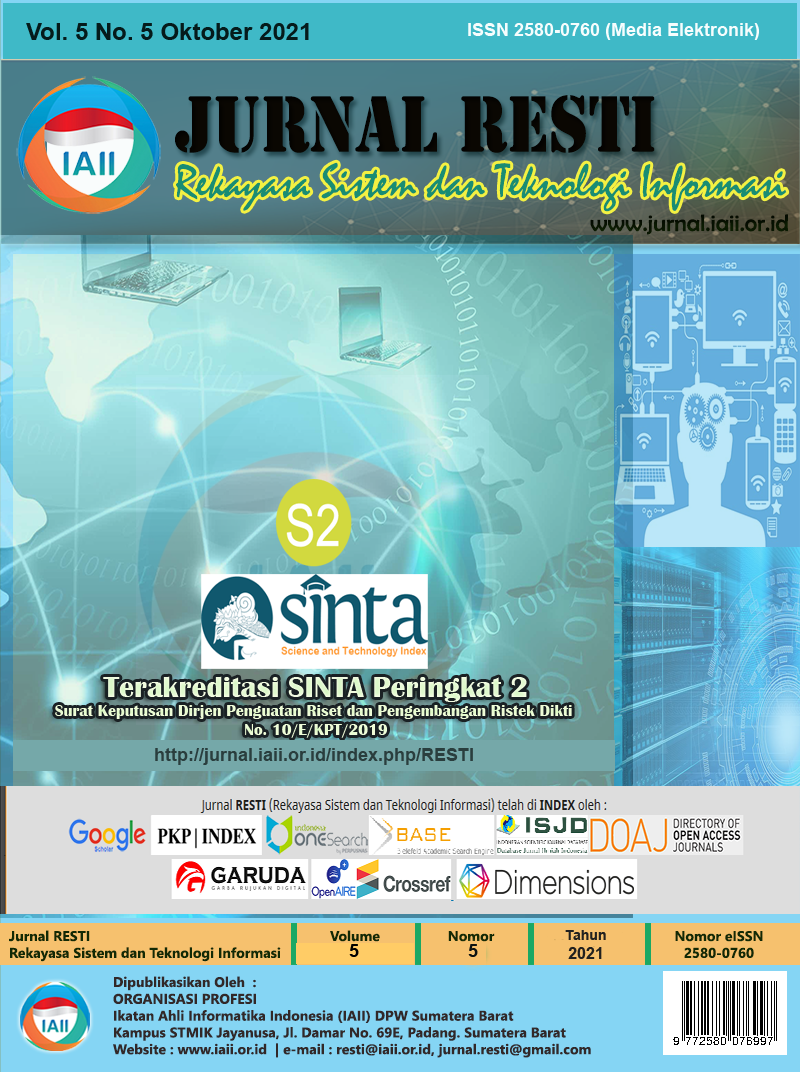Rancang Bangun Perangkat Komunikasi Adaptif Untuk Pengembangan QoS (Quality of Service) Infrastruktur Internet of Vehicle (IoV)
Abstract
The communication network is an important and vital component in the implementation of the Internet of Vehicle (IoV). The characteristics of IoV related to mobility, load, coverage area is very complex. The movement of connected nodes, communication load and wide coverage require reliable infrastructure support. Coupled with a high level of Quality of Service (QoS) for Internet of Vehicle (IoV) implementation which has a high risk if a communication system failure occurs. In this research, a system that has adaptive capability has been built in choosing a good connection infrastructure at the point where the unit is connected. Created a system that has the ability to connect to several communication network infrastructure. The system can switch to another provider when there is a connection that decreases its QoS level. The tests carried out resulted in better connection dynamics because there was an infrastructure backup. Although there are still many weaknesses because the distribution of network availability is still problematic. Anticipation of network overload can be anticipated with this system. The test results show that there is an increase in the percentage of lines connected to the new system. There is an increase in the percentage of connectivity around 10% to 20% compared to systems without connection backups.
Downloads
References
D. Arianto, N. Fauziah, and R. Randa, “Pemetaan Sebaran Lokasi Dan Analisis Jangkauan Area Pelayanan Menara Telekomunikasi Di 4 Kecamatan , Kabupaten Pasaman Barat ( Studi Kasus di Kecamatan Pasaman , Sasak Ranak pasisie , Kinali dan Luhak Nan Duo ),” 2019.
A. G. Palilu, “Studi Awal Perencanaan Jumlah Kebutuhan BTS dalam Penerapan Menara Bersama Telekomunikasi di Kota Palangka Raya,” Bul. Pos dan Telekomun., vol. 12, no. 4, p. 269, 2015.
F. Fummi, G. Lovato, D. Quaglia, and F. Stefanni, “Modeling of communication infrastructure for design-space exploration,” IET Semin. Digit., no. 2, pp. 92–97, 2010.
L. Ang, S. Member, and K. A. H. P. Seng, “Deployment of IoV for Smart Cities : Applications , Architecture , and Challenges,” IEEE Access, vol. 7, pp. 6473–6492, 2019.
X. Shen, R. Fantacci, and S. Chen, “Internet of Vehicles,” Proc. IEEE, vol. 108, no. 2, pp. 242–245, 2020.
O. Sadio, I. Ngom, and C. Lishou, “Rethinking Intelligent Transportation Systems with Internet of Vehicles : proposition of Sensing as a Service model,” 2017.
S. Khara, “Internet of Vehicles ( IOV ): Evolution , Architectures , Security Issues and Trust Aspects,” Int. J. Recent Technol. Eng., vol. 7, no. 6, pp. 268–280, 2019.
D. Kombate and Wanglina, “The Internet of Vehicles Based on 5G Communications,” IEEE Int. Conf. Internet Things IEEE Green Comput. Commun. IEEE Cyber, Phys. Soc. Comput. IEEE Smart Data, pp. 445–448, 2016.
M. Palmaccio, G. Dicuonzo, and Z. S. Belyaeva, “The internet of things and corporate business models: A systematic literature review,” J. Bus. Res., no. 7, p. 131, 2020.
H. L. Wang, G. A. Qiu, Bao, and W. Wang, “Dynamic Selection of D2D Communication for Internet of Vehicles,” IOP Conf. Ser. Mater. Sci. Eng., vol. 688, no. 3, 2019.
S. M. Hatim, S. J. Elias, N. Awang, and M. Y. Darus, “VANETs and Internet of Things (IoT): A Discussion,” Indonesian Journal of Electrical Engineering and Computer Science, vol. 12, no. 1. Institute of Advanced Engineering and Science, p. 218, 2018.
A. Nanda, D. Puthal, J. J. P. C. Rodrigues, and S. A. Kozlov, “Internet of Autonomous Vehicles Communications Security: Overview, Issues, and Directions,” IEEE Wirel. Commun., vol. 26, no. 4, pp. 60–65, 2019.
B. S. Pavan, M. Mahesh, and V. P. Harigovindan, IEEE 802.11ah for Internet of Vehicles: Design Issues and Challenges. 2021.
C. Li, L. I. Zhijun, and J. Shouxu, An Overview of Intelligent Transportation Systems based on the Internet of Things. 2013.
L. Tello-oquendo, “5G cellular system : A brief review of architecture , use cases , and enabling technologies,” 2020.
T. Manivannan and P. Radhakrishnan, “Preventive Model on Quality of Service in IOT Applications,” Int. J. Mech. Prod. Eng. Res. Dev., vol. 10, no. 3, pp. 1247–1264, 2020.
F. Arslan, B. Wajid, and H. Shafique, “Mobile GPS based Traffic Anomaly Detection System for Vehicular Network,” Int. J. Comput. Trends Technol., vol. 67, no. 6, pp. 31–36, 2019.
X. Wu, “A Robust and Adaptive Trust Management System for Guaranteeing the Availability in the Internet of Things Environments,” KSII Trans. Internet Inf. Syst., vol. 12, no. 5, pp. 2396–2413, 2018.
F. Yang, S. Wang, J. Li, Z. Liu, and Q. Sun, “An overview of Internet of Vehicles,” China Commun., vol. 11, no. 10, pp. 1–15, 2014.
S. Soim, Suroso, A. S. Handayani, A. Taqwa, and N. Shadrina, “The Implementation of YateBTS Based GSM Using Raspberry Pi,” J. Phys. Conf. Ser., vol. 1500, no. 1, 2020.
A. Winaya, G. Sukadarmika, and L. Linawati, “Analisis Penataan Sel Untuk Layanan Sistem WCDMA Di Area Jalan Tengah I Kerobokan,” Maj. Ilm. Teknol. Elektro, vol. 16, no. 2, p. 95, 2017.
A. H. Sodhro, “Quality of Service Optimization in an IoT-Driven Intelligent Transportation System,” IEEE Wirel. Commun., vol. 26, no. 6, pp. 10–17, 2019.
K. Z. Ghafoor, “Quality of service aware routing protocol in software-defined internet of vehicles,” IEEE Internet Things J., vol. 6, no. 2, pp. 2817–2828, 2019.
Copyright (c) 2021 Jurnal RESTI (Rekayasa Sistem dan Teknologi Informasi)

This work is licensed under a Creative Commons Attribution 4.0 International License.
Copyright in each article belongs to the author
- The author acknowledges that the RESTI Journal (System Engineering and Information Technology) is the first publisher to publish with a license Creative Commons Attribution 4.0 International License.
- Authors can enter writing separately, arrange the non-exclusive distribution of manuscripts that have been published in this journal into other versions (eg sent to the author's institutional repository, publication in a book, etc.), by acknowledging that the manuscript has been published for the first time in the RESTI (Rekayasa Sistem dan Teknologi Informasi) journal ;








